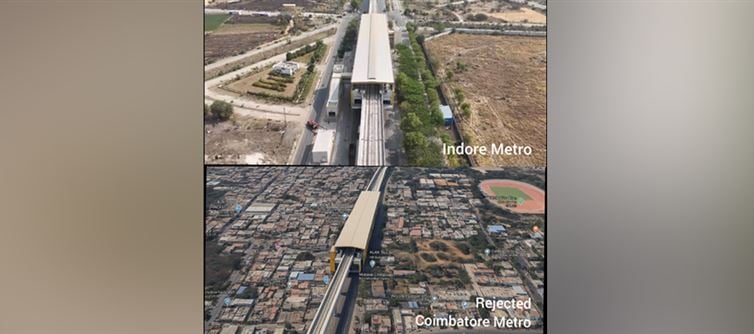
India’s infrastructure story has two realities: metros in some states get green-lit even when they barely have passengers to fill half a coach, while other states—especially in tamil Nadu—are grilled, stalled, and told to “prove demand” with microscopic scrutiny. And nothing exposes this lopsided yardstick better than the shocking ridership of indore Metro.
1️⃣ A Metro With Just 170 Passengers a Day — Yet No One Questions the Approval
indore Metro recorded just 5,067 passengers in the entire month of september 2025 — a humiliating average of ~170 riders a day across a 6.2 km stretch. That’s not low. That’s vanishing. Any other state would be roasted alive for this kind of ridership. But here? Silence. No think pieces. No “unviable project” debates. Just polite updates and PR spin.
2️⃣ A 97% Ridership crash — And Still No Accountability
Since launch, indore Metro’s footfall has plummeted by over 97%, turning a mega infrastructure project into a glorified tourist joyride. Operational costs are now massively outweighing revenue, yet no financial alarm bells ring in Delhi. Contrast this with tamil Nadu, where even well-planned metros are forced to justify themselves like they’re asking for a loan.
3️⃣ A Metro That Operates Only 4 Hours Per Day — Because Running It Longer Costs Money
Imagine spending thousands of crores on a “world-class” metro only to run it from 3 PM to 7 PM just to save on maintenance. That’s Indore’s airport Line right now — a public transport system functioning like a part-time evening hobby. But even this bizarre operational model doesn’t trigger outrage or scrutiny. The yardstick magically softens.
4️⃣ Early-Stage Excuses for North-Central Metros, Harsh Evaluations for tamil Nadu
Lucknow, Kanpur, and several newly launched metros with limited sections and thin ridership are treated as “projects in early stages.” Fair enough. But when coimbatore and madurai propose metros to meet booming urbanisation and future demand, suddenly the script flips — “use BRTS,” “metro not viable,” “ridership uncertain.” Why does “future proofing” apply selectively?
5️⃣ coimbatore and madurai Told to “Show Numbers” — While Others Get Blank Cheques
tamil Nadu cities are routinely sent back with demands for heavier studies, deeper ridership proofs, and alternative proposals like BRTS. Meanwhile, cities with weaker demand indicators glide through approvals with minimal resistance. The bias is subtle, polished, institutional — but unmistakable.
6️⃣ India’s Planning Yardstick Isn’t Uniform — and the Disparity Is Blindingly Obvious
The message is simple: metros with embarrassing numbers get protected reputations, while tamil Nadu gets pushed into proving its merit repeatedly. Infrastructure should be evaluated uniformly — but right now, it feels like some states are allowed to dream, while others are asked to justify why they should even try.




 click and follow Indiaherald WhatsApp channel
click and follow Indiaherald WhatsApp channel